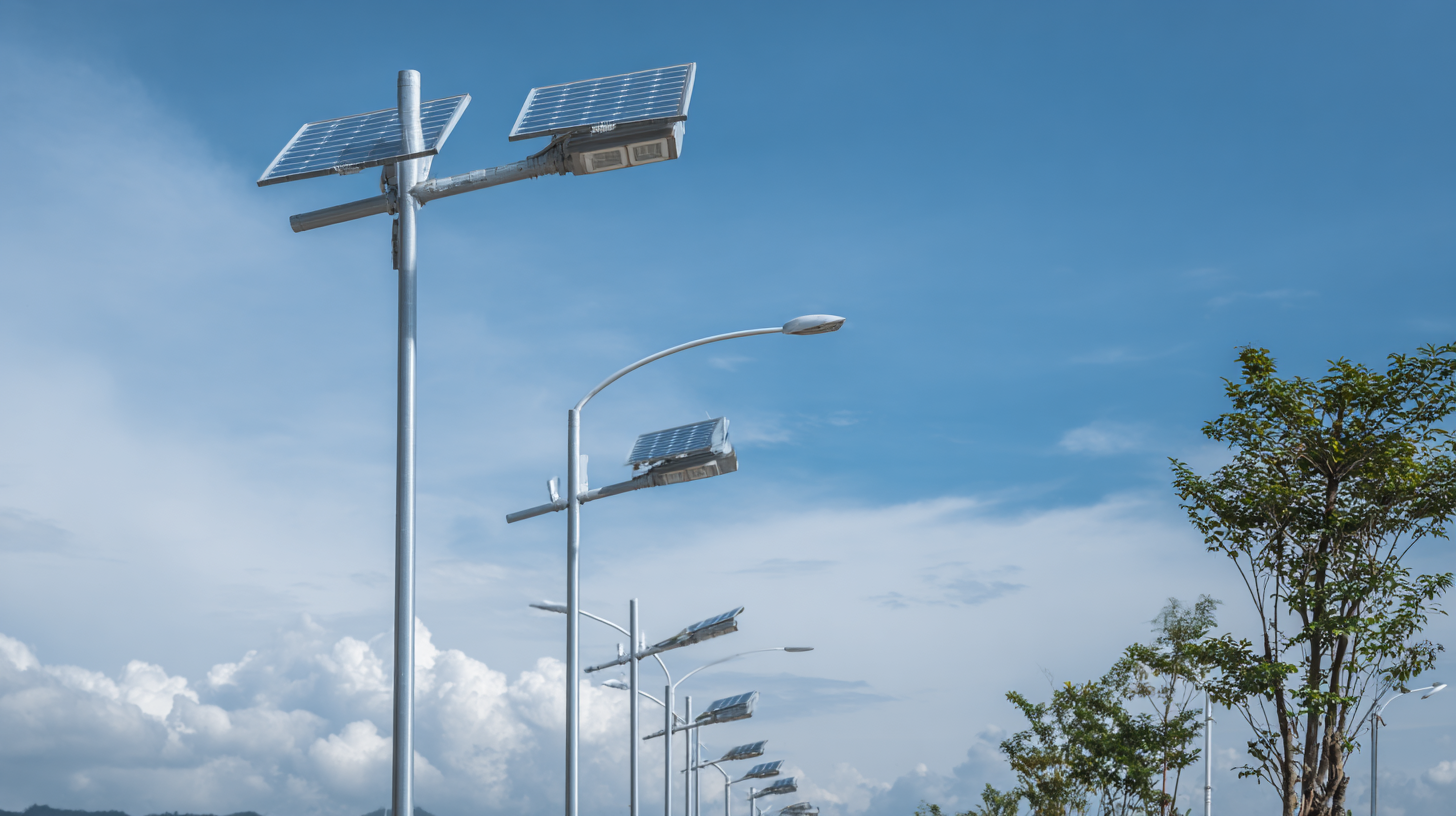Why Solar Street Lights Are the Future of Urban Lighting: Benefits and Innovations
 As urban areas continue to expand and populations grow, the need for
efficient and sustainable lighting solutions
becomes increasingly critical.
Solar street lights have emerged as a transformative technology,
offering not only significant cost savings but also environmental benefits.
According to a report by the International Renewable Energy Agency (IRENA),
the installation of solar-powered lighting can reduce energy consumption from traditional sources by over 80%,
leading to a remarkable decrease in greenhouse gas emissions. Furthermore, the
global market for solar street lights is projected to surpass
$15 billion by 2025, driven by innovations in solar technology and smart city initiatives.
With their ability to provide reliable illumination without dependence on the grid,
solar street lights represent a forward-thinking approach to urban lighting,
addressing both the needs of city planners and the growing demand for
sustainable solutions.
As urban areas continue to expand and populations grow, the need for
efficient and sustainable lighting solutions
becomes increasingly critical.
Solar street lights have emerged as a transformative technology,
offering not only significant cost savings but also environmental benefits.
According to a report by the International Renewable Energy Agency (IRENA),
the installation of solar-powered lighting can reduce energy consumption from traditional sources by over 80%,
leading to a remarkable decrease in greenhouse gas emissions. Furthermore, the
global market for solar street lights is projected to surpass
$15 billion by 2025, driven by innovations in solar technology and smart city initiatives.
With their ability to provide reliable illumination without dependence on the grid,
solar street lights represent a forward-thinking approach to urban lighting,
addressing both the needs of city planners and the growing demand for
sustainable solutions.
The Evolution of Urban Lighting: A Shift Toward Solar Solutions
The evolution of urban lighting has increasingly shifted towards solar solutions, marking a significant transformation in how cities illuminate their streets. Solar street lighting systems, equipped with photovoltaic panels mounted atop poles, harness the power of the sun to store energy and provide sustainable lighting. This transition is especially vital as the world grapples with rising climate change risks due to fossil fuel reliance. By integrating solar energy into urban infrastructure, cities can reduce their carbon footprint while also cutting operational costs associated with traditional lighting systems.
In recent years, innovations in solar technology have further enhanced the feasibility and appeal of solar street lights. These advancements not only improve energy efficiency but also ensure durability and reliability, even in challenging weather conditions. As urban areas expand and the demand for sustainable solutions grows, solar street lights represent a forward-thinking approach to urban lighting, aligning with global efforts to embrace green energy alternatives. This transformation in urban lighting reflects a commitment to sustainability, making solar solutions a cornerstone of modern urban planning.

Key Benefits of Solar Street Lights for Sustainable Cities
Solar street lights are rapidly gaining traction as a preferred choice for urban lighting, driven by their numerous benefits that align with the goals of sustainable cities. One of the primary advantages of solar street lights is their independence from the grid, reducing electricity costs and vulnerability to power outages. This self-sufficiency not only saves municipalities money but also alleviates the strain on traditional energy sources, showcasing a commitment to eco-friendly practices.
Additionally, solar street lights contribute significantly to reducing carbon footprints. By harnessing the power of the sun, these lights utilize renewable energy, effectively decreasing greenhouse gas emissions. This is crucial for urban areas seeking to combat climate change and promote cleaner air. Furthermore, advancements in solar technology have led to efficient, high-performance lighting solutions that improve public safety and visibility at night, ensuring that communities remain vibrant and secure without compromising environmental integrity.
Innovative Technologies Driving the Adoption of Solar Street Lighting
Innovative technologies are driving the rapid adoption of solar street lighting, transforming urban landscapes across the globe. According to a report by the International Renewable Energy Agency (IRENA), the global solar street lighting market is expected to grow at a compound annual growth rate (CAGR) of 20.8% from 2021 to 2026, reflecting an increasing emphasis on sustainable urban development. These lights utilize advanced LED technology, which not only offers superior illumination but also improves energy efficiency by consuming up to 75% less energy than traditional street lights.
Furthermore, integration of IoT (Internet of Things) enables smart functionalities like remote monitoring and adaptive brightness control based on pedestrian presence and environmental conditions. A study published in the Journal of Cleaner Production highlighted that solar street lights equipped with smart technology can lead to energy savings of up to 50% compared to conventional systems.
As cities continue to prioritize sustainability and energy efficiency, the innovative landscape of solar street lighting is set to redefine urban illumination, making it a pivotal component of future city planning.
Economic Advantages: Cost Savings and Long-Term Investment
Solar street lights represent a transformative shift in urban lighting, offering numerous economic advantages that make them a prudent choice for city investments. One of the most significant cost savings comes from reduced electricity bills. Traditional streetlights draw energy from the grid, leading to substantial monthly costs. In contrast, solar street lights harness renewable energy from the sun, significantly lowering operational expenses. This shift not only reduces the dependency on fossil fuels but also aligns with global efforts toward sustainability.

Moreover, the long-term investment potential of solar street lights is another compelling reason for cities to adopt this technology. Although the initial costs for installation can be higher than that of conventional lights, the savings accrued from lower maintenance and energy costs create a favorable return on investment over time. Solar street lights typically feature durable, low-maintenance designs that can withstand various weather conditions, minimizing replacement and repair expenses. Additionally, the increased safety and visibility provided by solar lighting can enhance property values and community engagement, creating a more attractive urban environment.
Environmental Impact: Reducing Carbon Footprints with Solar Lighting
The environmental impact of solar street lights is significant, offering a sustainable alternative to traditional urban lighting solutions. By harnessing solar energy, these lights drastically reduce reliance on fossil fuels, leading to a decrease in carbon emissions. Unlike conventional street lights that draw energy from the grid, solar-powered options generate electricity from sunlight, enabling cities to lower their carbon footprints. This shift not only contributes to cleaner air but also helps combat climate change, making urban environments more eco-friendly.
Moreover, solar street lights promote biodiversity and environmental stewardship. Many installations incorporate smart technology, allowing them to adjust brightness based on real-time demand, which further enhances energy efficiency. As cities adopt these innovations, they contribute to a healthier ecosystem, minimizing light pollution and its adverse effects on wildlife habitats. In essence, transitioning to solar street lighting not only addresses urban lighting needs but also aligns with global efforts to create a sustainable future, benefiting both the environment and urban dwellers alike.
Related Posts
-

Empowering Global Trust: Premium Solar Street Lamps from Leading Chinese Manufacturers
-

Transforming Urban Landscapes: The Rise of Solar Powered Street Lights in Modern City Planning
-

Essential Tips for Sourcing Top Manufacturers of Best Solar Walkway Lights
-

Envisioning Tomorrow: The Revolution of Commercial Solar Lights
-

7 Best Pathway Lights to Illuminate Your Garden This Year
-

5 Reasons Why Walkway Lights Are the Best Investment for Your Home
